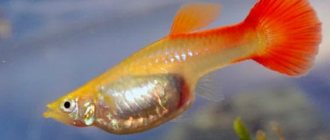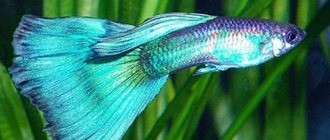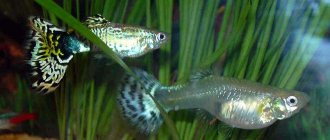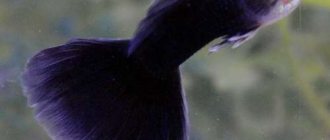"Ring" of illness
Experienced aquarists know that the eyes of fish are a kind of indicator of their health. The eyes may become cloudy, dull, or even black. What to do? What should I do? Let's look at the reasons for the darkening.
"Ring" of illness
Why do guppy eyes turn dark?
- the water condition has decreased. It is likely that the ammonia level has been exceeded;
- water parameters changed dramatically. Darkening of the eyes in fish is a reaction to drugs;
- the fish were stressed. It can be caused by childbirth, cleaning the aquarium with a siphon, etc.;
- mutation of an aquatic inhabitant. May be the cause of a close relationship.
How to fix the disease
It is imperative to aerate the water, change the water in the aquarium daily, and during the treatment period add table salt to the water space in a ratio of 1 gram per 1 liter of water.
Increasing the number of plants in the aquarium will have a great effect on the health of the fish. It could be an ordinary hornwort for an aquarium, which can change the situation in a favorable direction.
To refresh the gene pool, introducing males will help. They are able to change the situation for the better.
What to do
If your goldfish turns white, you need to carefully examine it to detect diseases. A white, grayish coating, an enlarged belly, and low mobility of the fish are signs of the disease. Most often, the cause of such pallor is a fungal disease.
Antibak 250 is a good remedy for fungal diseases of aquarium fish and should be used strictly according to the instructions. Sometimes adding table salt to the aquarium in a concentration of no more than 1.5 g/l helps out the fungus. Treatment with salt is allowed for one to two weeks, after which the salt concentration is reduced by gradually changing the water.
In cases where the fish has turned white due to lack of lighting, temperature, dry food or faded soil, then by changing all the initial conditions, you can achieve brighter shades of the scales and fins of the fish. The exception is goldfish of certain breeds with a white color.
Fish disease
Unfortunately for aquarium owners, there is bad news. An aquatic inhabitant may have mycobacteriosis or even tuberculosis. Signs of the disease are:
- loss of appetite and the formation of thinness as a consequence;
- lowered tail and retracted belly of the fish;
- faded color;
- change in behavior: guppies hide every now and then, stay closer to shelters and the bottom;
- the fish began to hump.
Based on the scientific view, mycobacteriosis cannot be defeated, but aquarists say that they managed to do this. How? First, you should examine all the inhabitants of the water space, because tuberculosis is contagious. Therefore, all “strange” fish should be immediately removed, and then the aquarium should be washed.
When treating fish, it is recommended to use antibiotics and salt, which are mixed into the food. Remember that if you succeed in treatment and the guppies survive, their immune system will still be seriously damaged, so they can easily get sick, putting their companions at risk of infection.
What not to give to fish: 4 prohibited foods
Source
Strange behavior, what causes it
The strange behavior of guppies is almost always caused by various diseases. If the fish swims on its side, this is a cause for concern, since this is a symptom of a dangerous disease - glucose disease. Other signs include swelling of the eye or bulging eyes appearing on only one side. The cause of the disease is parasites that multiply quickly and affect the liver, stomach, eyes, and gills. Glugosis is an incurable disease and all guppies die. If the diagnosis is confirmed, all contents of the aquarium are destroyed and the tank is disinfected.
To avoid infection of all fish, new individuals need to be kept in quarantine and only after making sure that the pet is not sick, it is transplanted into a common container.
If a guppy swims with its belly up, there can be many reasons, here are the most common:
- Helminthic infestations.
- Viral or infectious diseases.
- General weakness.
- Oncological or fungal diseases.
- Severe gas formation in the intestines.
- Swim bladder diseases.
- Poor nutrition.
The cause is usually considered to be an inflammatory process in the bladder - this is a contagious disease caused by pathogenic microorganisms. Infection occurs due to poor quality food or water.
If treatment of the disease is started at the first stage, the prognosis is positive. During treatment, the fish should be left without food, this will stop the inflammation.
The lifespan of the fish also influences behavior. Determining the age of a guppy is difficult, but if you are careful, you can see the difference. Young fish have a simple body shape. Growing up pets have a more convex belly, a slight arch on the back, which increases with aging. Guppies up to six months have a fiery disposition and although they have color, the tail is still at the development stage. Adult fish are calmer, after 1 year the color is at its peak.
Black eyes in guuppies - a disease or normal
The guppies' eyes have turned black, for some aquarists this is a cause for concern, for others this situation will throw them into panic, and for others they will say - yes, this is the norm! Let's find out how things really are. Who will be right, or the truth, as always, is somewhere in between... read and find out. If you noticed that your pets' eyes have darkened, then, of course, the first thing you did was ask this question on the Internet and what did you find? This topic is actively discussed on many forums, but everything is chaotic and incomprehensible... Well, for clarity, I will say that I have 2 news for you, as usual, good and bad.
There is a possibility that you should calm down and take a closer look at the fish; perhaps your vision has suddenly darkened due to light refraction or another optical illusion.
Heredity
Black eye color is normal for dark-colored guppies.
Let's start, as usual, with good news - perhaps the guppy inherited black eyes. In many species of guppies, especially those with a pronounced dark color, black eyes are quite common . “But mine are not black, maybe even outbred,” you say. This does not mean that the good news mentioned is not your case; it is quite possible that distant relatives of your guppies had a dark color and passed on dark eyes to their descendants (even very distant ones). So there's nothing to worry about.
Eyes as an indicator of disease
The eyes of a fish serve as a kind of indicator of its condition. They may become cloudy, dull, or like our guppy has black eyes. What does this mean? What to do? First things first. Causes of darkening:
- The water condition has deteriorated - excess ammonia
- A sharp change in parameters - a reaction to drugs - EasyBalance, Iodobalance, etc.
- Stress experienced - anything from childbirth to cleaning an aquarium with a siphon
- Mutation - the cause of which is closely related relationships
Briefly about how to help the fish if you suspect the root of your trouble is in one of the listed points. Aeration is required, if possible, increase the volume of air the guppies receive, change the water daily, and add table salt to the water in the proportion of 1 gram during the treatment period. per 1 liter . Increase the number of plants in the aquarium, even if it is the simplest hornwort, but perhaps it will change the situation for the better. Regarding the last point, try to acquire new males from time to time to refresh the gene pool.
Treatment of ringworm
Before starting treatment, prepare a septic tank. In this case, the drug “Bicillin” is used. This is an effective remedy for the treatment and prevention of infectious fish diseases. For 50 liters of water, 250,000 units of the composition are required. A diluted drug is added to the water. The procedure is performed within 4-6 days. The temperature in the container at this time should be at 26 degrees.
All items in the aquarium and plants are treated with antifungal compounds.
Worst option
Unfortunately, as mentioned above, there is also bad news, and it is that the only disease one of the symptoms of which is black eyes in gupi is Mycobacteriosis or fish tuberculosis. A serious illness, the symptoms of which I will list below:
Darkened eyes can be one of the signs of tuberculosis.
- Loss of appetite, resulting in thinness;
- The tail is lowered, the stomach is pulled in;
- The color fades;
- Behavior changes - the guppy always tries to hide, stay closer to the shelter, to the bottom;
- The fish is hunched over;
From a scientific point of view, mycobacteriosis is invincible, however, there are aquarists who claim that they have succeeded. How?! First of all, inspect all the inhabitants of the aquarium - tuberculosis is contagious! Immediately remove all suspicious comrades and wash the aquarium properly . To treat sick fish, salt and antibiotics mixed into the food are used. Remember that even if your treatment is successful and the fish survive, their immunity has been seriously damaged and they may well get sick again and endanger all their neighbors.
Plistophorosis
Plistophora is one of the most dangerous diseases of aquarium guppy fish, which is transmitted from mother to fry. Recognizing the disease is quite simple: the fish become pale and stop eating, which leads to great exhaustion. The body position of the fish changes: the tail goes down, and the body is at an angle of 45-60 ° C, while the fish make jerking movements.
The parasite lives in the muscle tissue of fish, so the body of the infected fish becomes deformed and movements become spasmodic.
In case of fish disease with plistophora blight, all fish should be immediately destroyed , the soil should be boiled, and plants and equipment should be thoroughly disinfected.
Why do fish start to die?
Newbie mistakes lead to the death of fish. The most common ones are listed below.
Water pollution
Guppies die from contamination in the aquarium, which causes disease, poisoning and lack of oxygen. The liquid must be free of impurities and dechlorinated.
Nitrogen poisoning
When poisoned by nitrogen compounds, the fish's eyes bulge and it shows signs of oxygen starvation. Increase aeration and replace up to 40% of the liquid. Find out how much the concentration of nitrogen compounds in the water is and neutralize the excess using conditioners.
Water temperature
If guppies are kept at inappropriate temperatures (22-28 degrees), they are susceptible to disease. A sudden change in temperature leads to temperature shock and death.
Incorrect launch of fish
Neglecting quarantine when introducing a new fish can lead to the fish dying one by one. The new fish should be observed in a separate container for at least 3-4 weeks, and only if there are no diseases can it be placed in a common aquarium. It is also necessary to gradually adapt newly acquired fish to the conditions of a particular aquarium. Do not release the fish from the bag into the aquarium immediately; add new water little by little every 15–20 minutes.
Fish diseases
Diseases are a common cause of death. Observe the behavior and appearance of the fish, do not delay treatment if you suspect a disease.
Water quality
The quality of the water environment is declining due to:
- Irregular or incomplete aquarium maintenance. Proper care involves siphoning the soil, replacing 25% of the total volume of liquid with clean liquid, and washing the decorations and filter components.
- Overfeeding Excess feed falls to the bottom, polluting the water. Feed your pets small portions and fast them once a week.
- Overpopulation. In a densely populated aquarium, the liquid becomes contaminated faster.
- Lack of equipment. The liquid needs constant filtration and aeration. An aquarium without equipment requires frequent water changes.
O2 deficiency
Lack of oxygen occurs when there is overcrowding. Guppies concentrate at the surface of the water and greedily swallow air. Connect the compressor. Remember that in summer, oxygen consumption increases due to rising temperatures. Turn off the lamp and cool the water by immersing bottles and ice packs in the aquarium.
Aggressive neighbors
Harassment from neighbors is another cause of death for guppies. Incorrect compatibility leads to injury and severe stress. Aggressive neighbors can chase the fish to death and even eat it.
Acclimatization
Not all guppies can survive adaptation to new conditions and transportation. Old and weak fish often die, even if the aquarist has caused little concern to the pets.
First aid
Not all diseases of aquarium fish are curable. There is no universal method to help with those ailments that can be treated. However, any aquarist should know a number of initial measures to help a sick fish.
- It is best to remove a sick fish from the general aquarium in order to carry out treatment. This way she won’t infect others, and it will be more convenient to treat her.
- When preparing a fish tank (for guppies, a regular jar with a capacity of 2 liters or more is enough), use water from a common container, mixing it with fresh water.
- The water in the reservoir is changed daily. Aeration is not necessary.
- The water should be salted - 1 gram per liter, and add a few drops of iodine. When changing the water, the concentration of nutrients should be restored.
- It is best to feed a sick pet with live food - it is more nutritious and will allow her to recover faster. Bloodworms are perfect.
- The volume of water in the hatchery is very small, it spoils easily, so feed carefully and immediately remove uneaten food debris.
- Such measures are only first aid; then, having accurately identified the disease, more serious treatment can begin. However, in cases that are not too severe, the first measures can help.
Diseases
The list of diseases of aquarium fish is huge; experienced aquarists and people with special education understand them. If you lack experience, it is better to consult a doctor.
Fin rot
The disease appears in dirty water when the fins are injured. If you ignore the disease, after the destruction of the fins, damage to the body will begin and the fish will die. Fin rot is treated:
- Salt baths. Immerse the sick individual in a solution of table salt (3 tablespoons per 5 liters of water) for 10–15 minutes. Treat the decorations and soil.
- Levomycetin. Dissolve 1 tablet for every 20 liters of water. Once every three days, add a solution in an amount of up to 30% of the aquarium volume. Carry out treatment until complete recovery.
There are many methods for treating fin rot. The treatment is discussed in detail in a separate article.
Plistophorosis
The disease is also called “neon disease” and pleistophorosis. The fish's muscles are affected and ulcers appear on the body. Plistophorosis cannot be treated; the diseased individual must be destroyed. Boil the soil and decor, rinse the aquarium.
Red scab
The disease most often affects males. Remove the parasite-affected areas of the fins with a blade. Place the guppies in salted water (1 g salt per 1 liter). Treat in combination with levomycin (1 tablet per 30 l) or furazolidone (0.5 tablets per 10 l). The course of treatment is 5 days. Remedies for ichthyophthyriosis also help. The tail grows back after some time.
Breeding problems
Guppies easily breed in an aquarium, but in some cases, owners note problems in breeding fish. Main reasons:
- Hermatophrodism - it is difficult to detect the disease during visual examination, since female guppies have male genital organs at the same time as female ones. The causes and treatments are not yet clear.
- Infertility is a disease when females are unable to give birth. The color of the guppies loses its saturation, the fish become faded. The causes of the disease are very powerful, bright or prolonged lighting. This disease has no cure.
Problems of juvenile development
The first symptoms that indicate poor health in guppy fry are lethargic behavior and loss of appetite. The fry are always at the bottom of the aquarium or swim near the surface of the aquarium. Problems arise due to poor water quality, irregular cleaning and significant reservoir population.
Stages of growth of guppy fry from birth to adulthood.
The birth of fry with a deformed body or underdeveloped fish with yolk sacs is a sign of improper keeping of the female in the aquarium.
Timely diagnosis of the disease and its correct treatment is an important stage. Sick guppy fry need to be transplanted and the nursery should be disinfected. This will save the rest of the brood from death.
Adviсe
- Before you buy new fish, find out what species they are, their environment, and whether they are compatible with guppies.
- A spare aquarium is required for quarantine of new fish, treatment and spawning.
- If you notice something strange in the behavior and appearance of fish in a pet store, refuse to purchase.
- If it is necessary to improve the conditions of water inhabitants, do it gradually. Any sudden changes in the aquatic environment are a source of stress for pets.
- Fish are more comfortable in a rectangular tank rather than a round one.
Advice and treatment methods vary greatly from one source to another. Sometimes sellers in pet stores give harmful recommendations. Consult with experienced aquarists and veterinarians and check the information carefully.
Source
Problems with reproduction
Aquarium guppies readily breed in captivity, but sometimes owners encounter problems in breeding their pets. The reasons why guppy fish cannot reproduce are:
- Infertility is a disease in which females are unable to produce offspring. At the same time, the color of the fish loses its saturation, the guppies become pale and dull. The causes of infertility are excessive duration of illumination or bright, powerful light. Unfortunately, it is impossible to get rid of this disease.
- Hermatophrodism - the disease is difficult to detect upon visual examination, since female guppies also develop male reproductive organs along with the female organs. The causes and treatments are not yet known.











